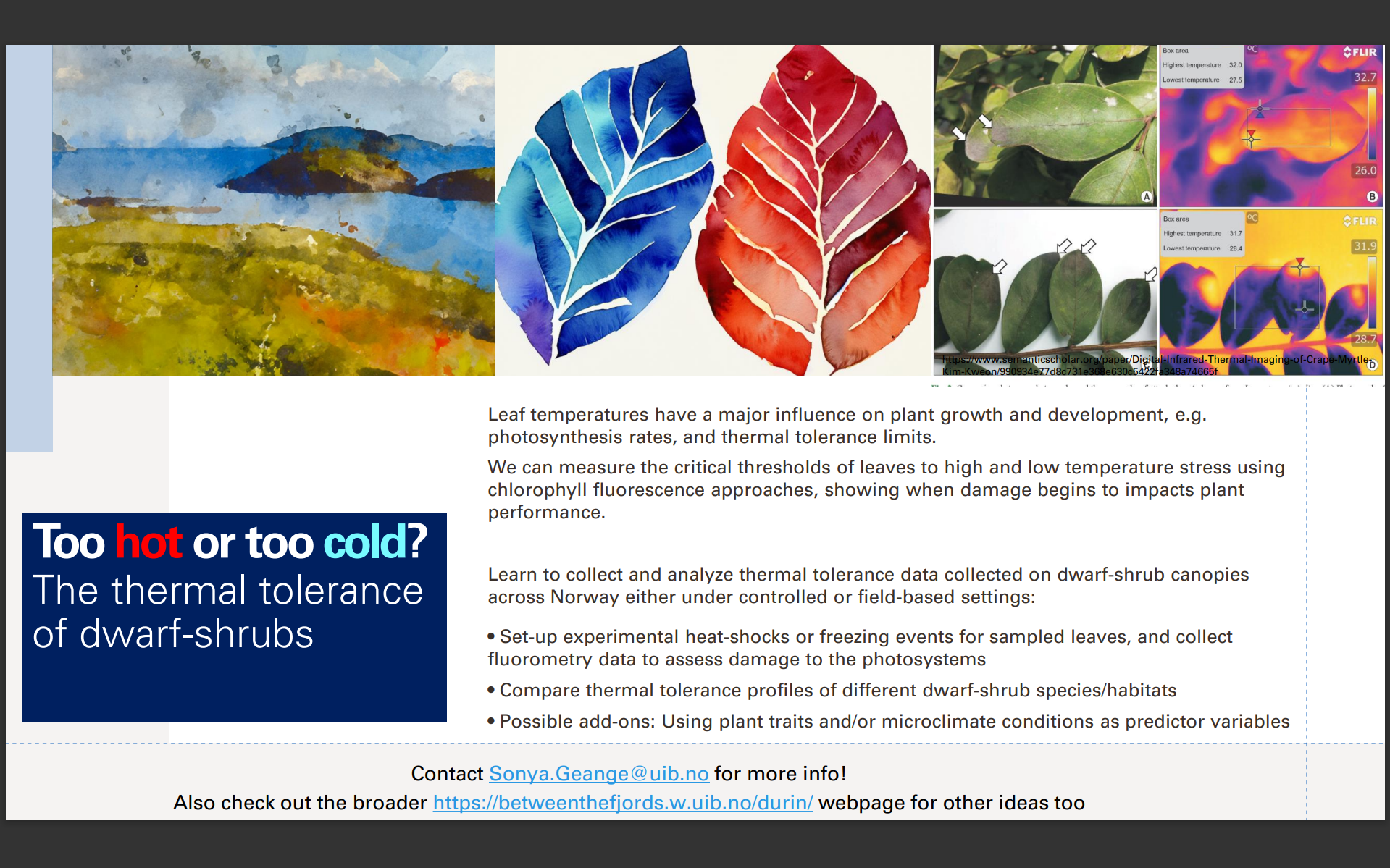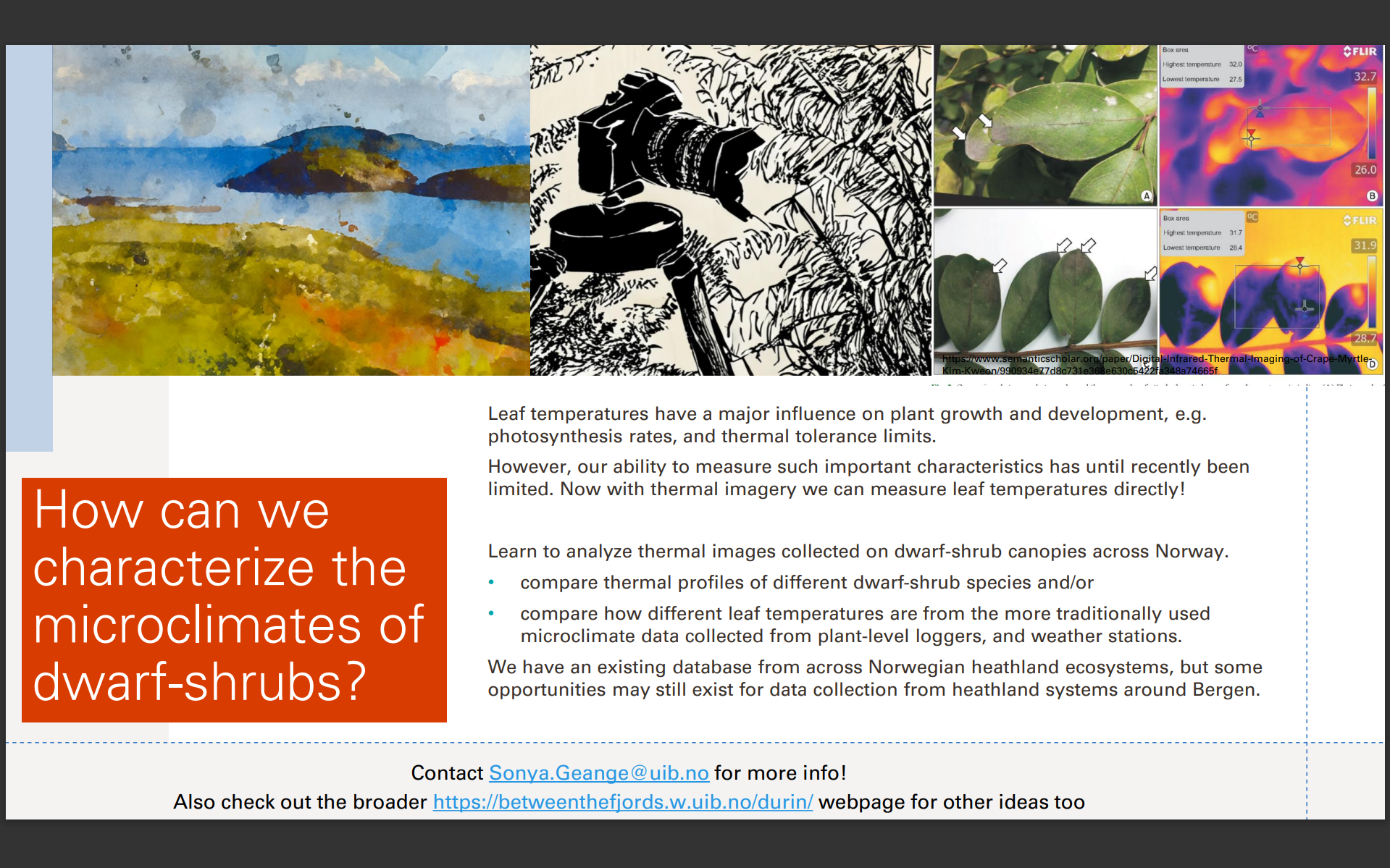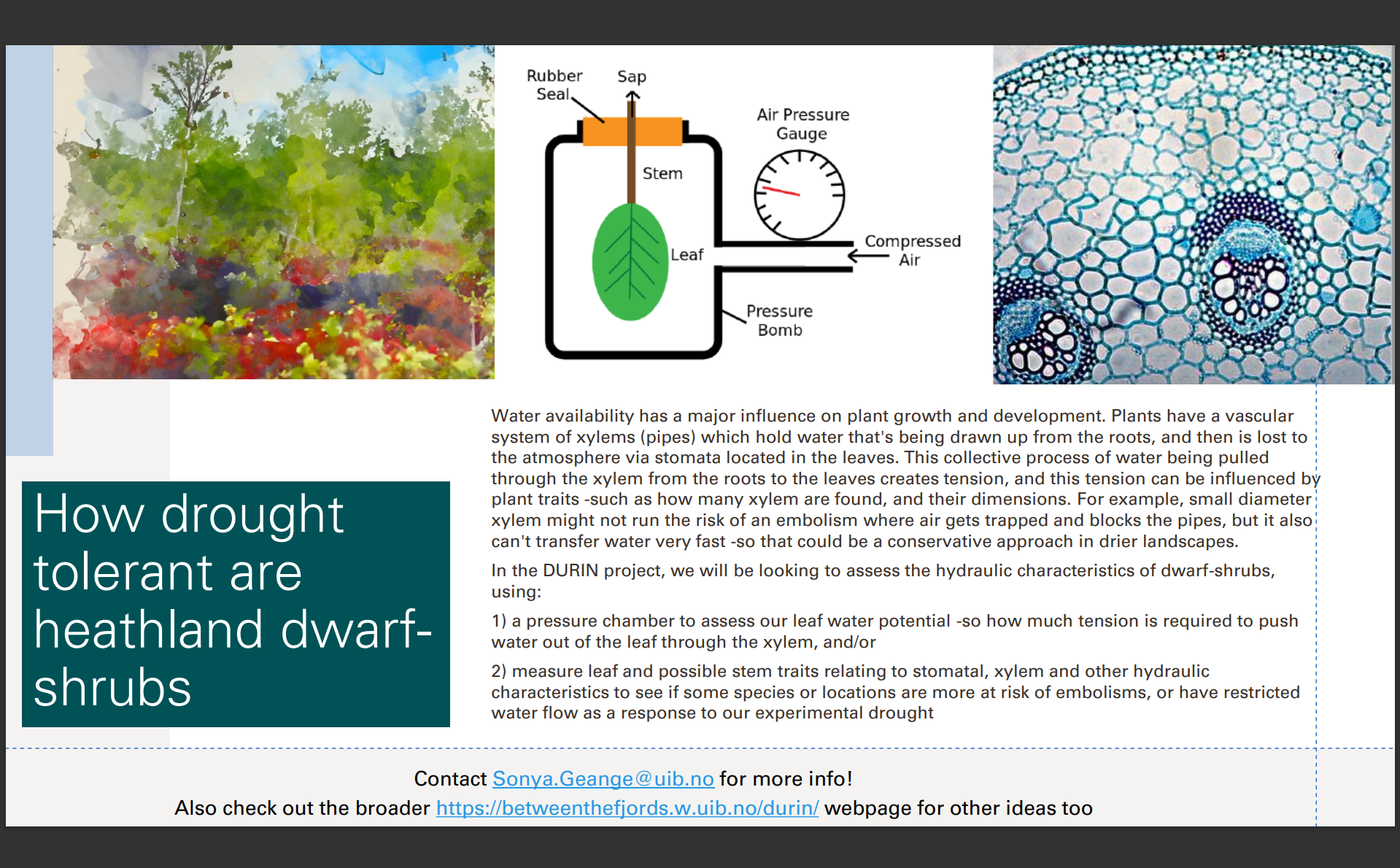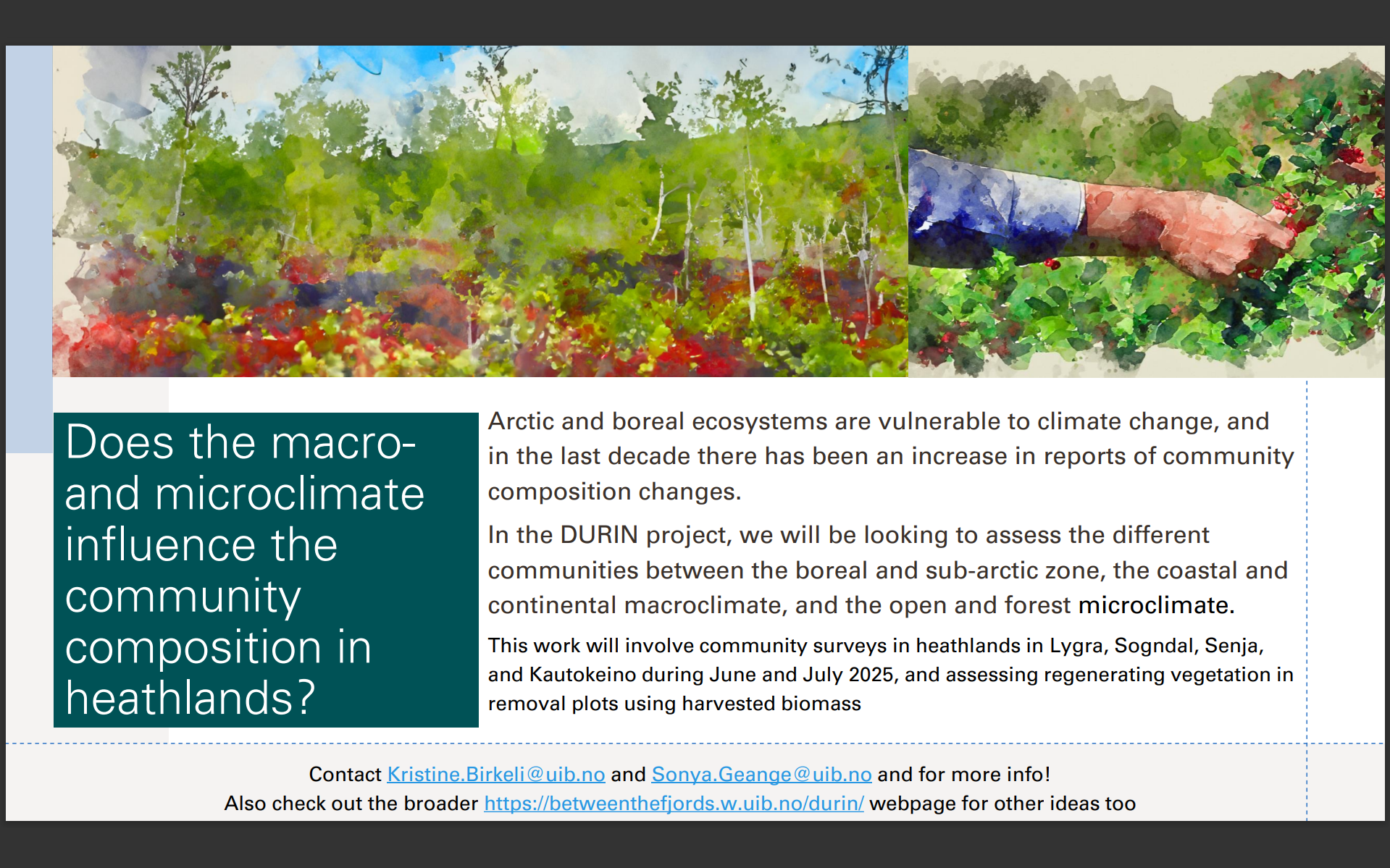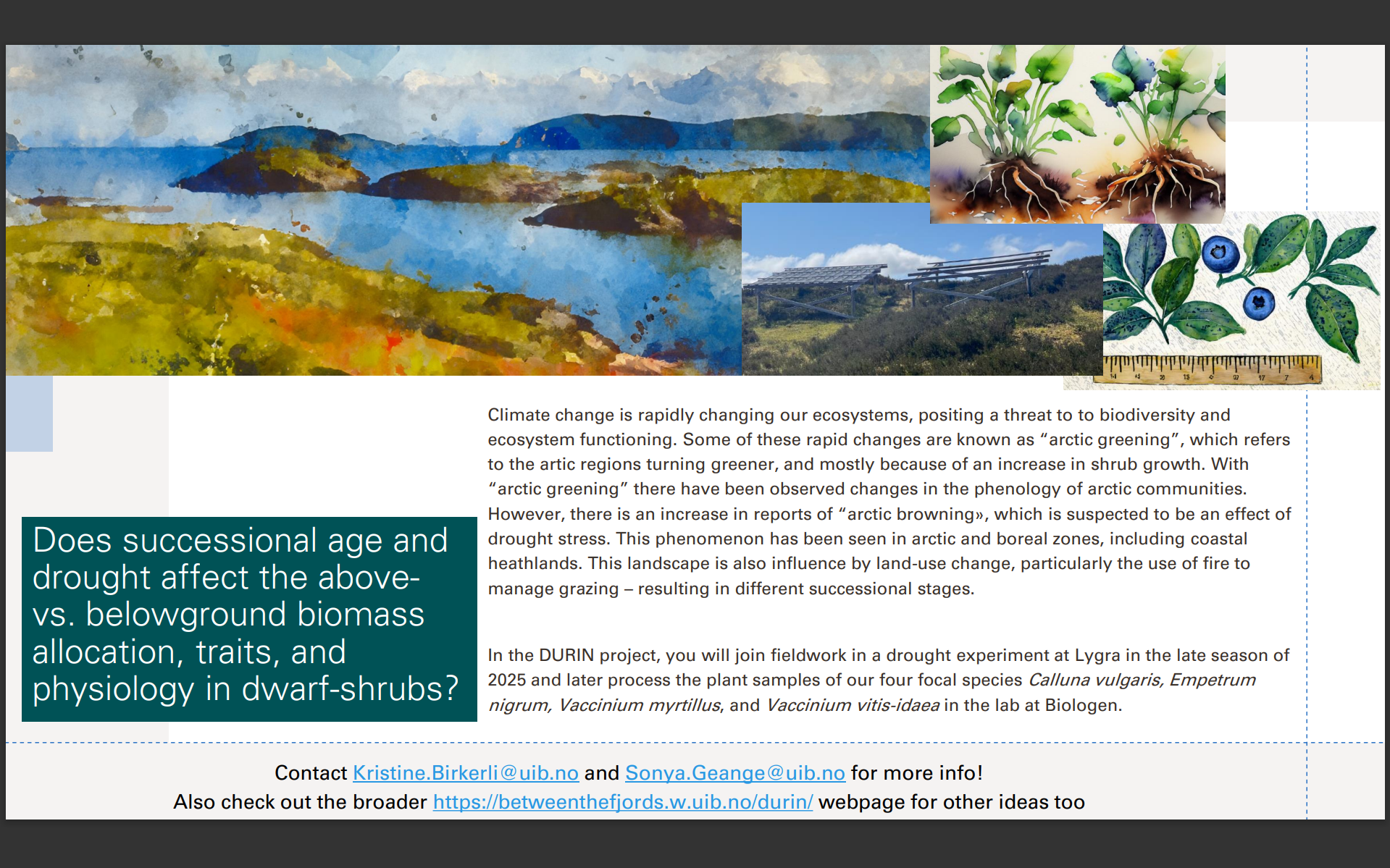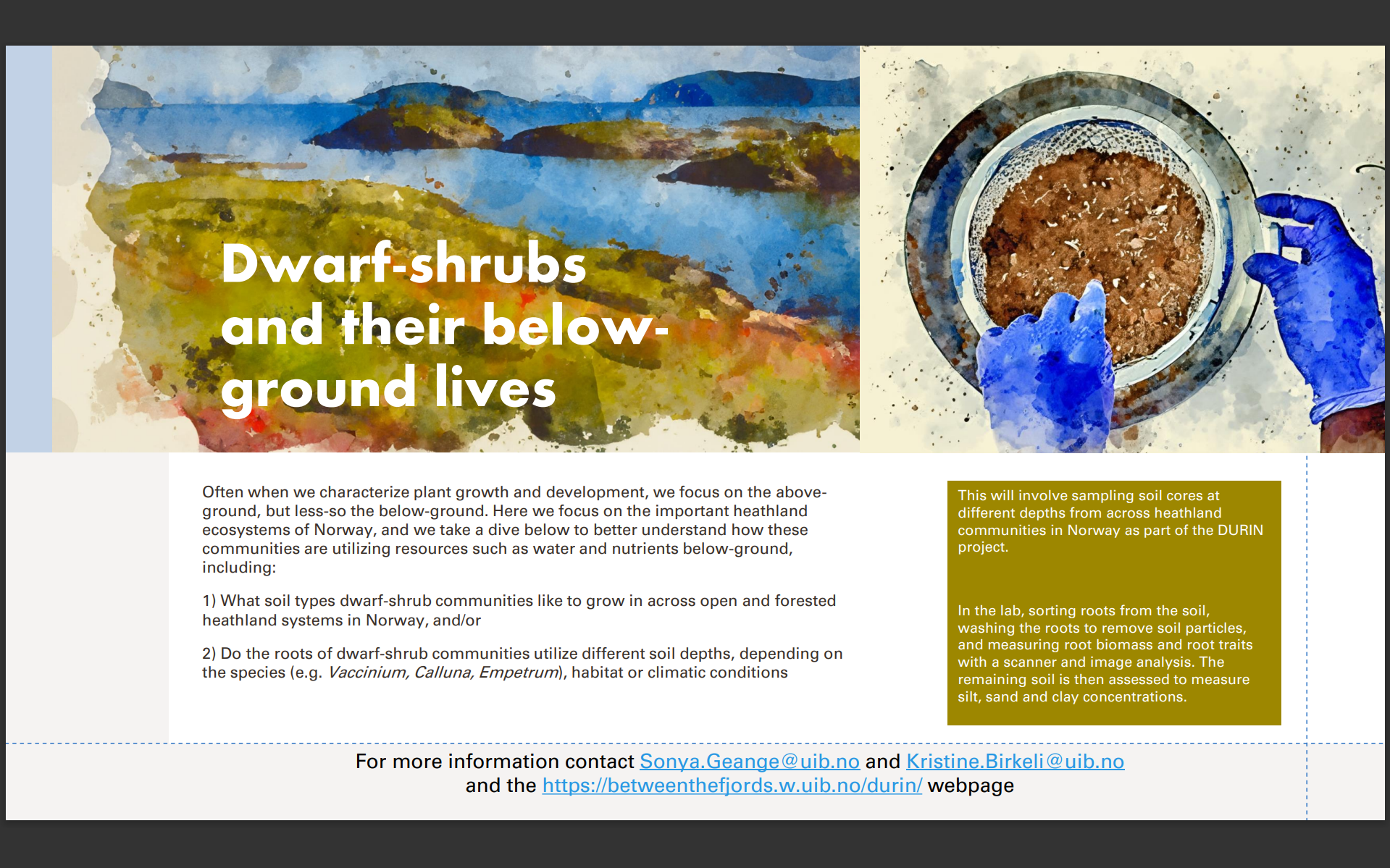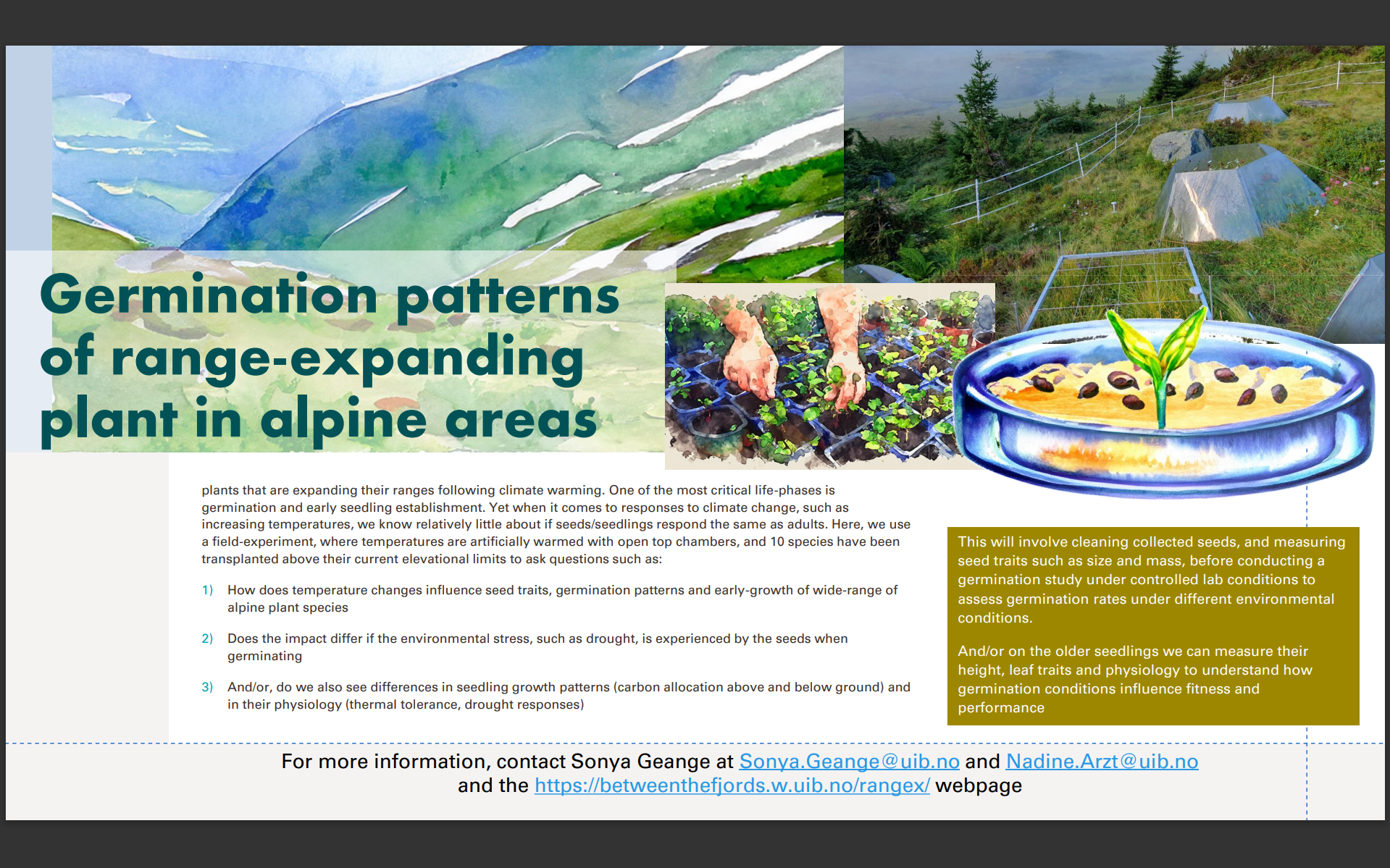Background
Dwarf-shrubs (Ericaceae) are a dominant plant functional group across the boreal, arctic, and alpine biomes, where they play important roles for biodiversity, ecology and ecosystem functioning. For example, dwarf-shrubs provide important food resources for grazers, pollinators, and people, they are habitat for other plants, insects, rodents, and birds, and through interactions with belowground fungal networks (ericoid mychorriza), they play critical roles in carbon sequestration and long-term carbon storage in soils.
Despite their broad climatic and geographic ranges and dominant roles across boreal, arctic, and alpine vegetation zones, dwarf-shrub can be quite sensitive to climate changes and climate variability, as shown by their key roles in 'arctic greening' and 'arctic browning' events. This suggests that dwarf-shrubs may play a critical role in both the responses and the feedbacks between terrestrial ecosystems and the climate system.
DURIN will explore the role of dwarf-shrubs in climate responses and feedbacks across biomes and habitats, integrating plant physiology, ecology, ecosystem, and climate science. Using distributed observational systems, field experiments, and growth chamber studies; we will obtain fundamental knowledge on how climate change directly and indirectly affects this important plant functional group, and it’s ecosystem functions and services. This improved process understanding will be integrated in land surface and earth system models to understand the role and contribution of dwarf-shrubs in the feedbacks from terrestrial vegetation to the climate system.
Supervisors
Sonya Geange Sonya.Geange@uib.no
Kristine Bikeli Kristine.Birkeli@uib.no
Mika Kirkhus Mika.Kirkhus@uib.no
Potential project ideas
Leaf temperatures have a major influence on plant growth and development, e.g. photosynthesis rates, and thermal tolerance limits.
We can measure the critical thresholds of leaves to high and low temperature stress using chlorophyll fluorescence approaches, showing when damage begins to impacts plant performance.
Learn to collect and analyze thermal tolerance data collected on dwarf-shrub canopies across Norway either under controlled or field-based settings:
- Set-up experimental heat-shocks or freezing events for sampled leaves, and collect fluorometry data to assess damage to the photosystems
- Compare thermal tolerance profiles of different dwarf-shrub species/habitats
- Possible add-ons: Using plant traits and/or microclimate conditions as predictor variables
Leaf temperatures have a major influence on plant growth and development, e.g. photosynthesis rates, and thermal tolerance limits.
However, our ability to measure such important characteristics has until recently been limited. Now with thermal imagery we can measure leaf temperatures directly!
Learn to analyze thermal images collected on dwarf-shrub canopies across Norway.
- compare thermal profiles of different dwarf-shrub species and/or
- compare how different leaf temperatures are from the more traditionally used microclimate data collected from plant-level loggers, and weather stations.
We have an existing database from across Norwegian heathland ecosystems, but some opportunities may still exist for data collection from heathland systems around Bergen.
Water availability has a major influence on plant growth and development. Plants have a vascular system of xylems (pipes) which hold water that's being drawn up from the roots, and then is lost to the atmosphere via stomata located in the leaves. This collective process of water being pulled through the xylem from the roots to the leaves creates tension, and this tension can be influenced by plant traits -such as how many xylem are found, and their dimensions. For example, small diameter xylem might not run the risk of an embolism where air gets trapped and blocks the pipes, but it also can't transfer water very fast -so that could be a conservative approach in drier landscapes.
In the DURIN project, we will be looking to assess the hydraulic characteristics of dwarf-shrubs, using:
1) a pressure chamber to assess our leaf water potential -so how much tension is required to push water out of the leaf through the xylem, and/or
2) measure leaf and possible stem traits relating to stomatal, xylem and other hydraulic characteristics to see if some species or locations are more at risk of embolisms, or have restricted water flow as a response to our experimental drought
Often when we characterize plant growth and development, we focus on adult’s that are already established. However, one of the most critical life-phases is germination and early seedling establishment.
Here we focus on the important coastal heathland ecosystems of Norway, and we ask:
1)How do environmental factors such as drought or temperature changes influence early-growth of dwarf-shrubs, and does that impact differ if the environmental stress is experienced by the maternal plants (in the field) or by the seeds when germinating.
2)Do we also see differences in seedling growth patterns (carbon allocation above and below ground) and in their physiology (thermal tolerance, drought responses)
This will involve cleaning collected seeds, and measuring seed traits such as size and mass, before conducting a germination study under controlled lab conditions to assess germination rates under different environmental conditions.
And/or on the older seedlings we can measure their height, leaf traits and physiology to understand how germination conditions influence fitness and performance.
Arctic and boreal ecosystems are vulnerable to climate change, and in the last decade there has been an increase in reports of community composition changes.
In the DURIN project, we will be looking to assess the different communities between the boreal and sub-arctic zone, the coastal and continental macroclimate, and the open and forest microclimate.
This work will involve community surveys in heathlands in Lygra, Sogndal, Senja, and Kautokeino during June and July 2025, and assessing regenerating vegetation in removal plots using harvested biomass
Climate change is rapidly changing our ecosystems, positing a threat to to biodiversity and ecosystem functioning. Some of these rapid changes are known as “arctic greening”, which refers to the artic regions turning greener, and mostly because of an increase in shrub growth. With “arctic greening” there have been observed changes in the phenology of arctic communities. However, there is an increase in reports of “arctic browning», which is suspected to be an effect of drought stress. This phenomenon has been seen in arctic and boreal zones, including coastal heathlands. This landscape is also influence by land-use change, particularly the use of fire to manage grazing – resulting in different successional stages.
In the DURIN project, you will join fieldwork in a drought experiment at Lygra in the late season of 2025 and later process the plant samples of our four focal species Calluna vulgaris, Empetrum nigrum, Vaccinium myrtillus, and Vaccinium vitis-idaea in the lab at Biologen.
An increasing trend found in arctic and subarctic regions is “arctic browning”, which refers to the massive dieback of dwarf-shrubs, causing the vegetation to go brown. One of the effects found from these events was a reduced level of gross primary production and net ecosystem exchange, which could indicate a weakening of the carbon sink capacity of arctic and subarctic ecosystems.
With the arctics short growing season and longer days, compared to the boreal longer growing season and shorter days, do we see a different pattern in the net ecosystem exchange in heathlands throughout the diurnal cycle?
You will join us for fieldwork in heathlands found at Lygra, Sogndal, Senja, and Kautokeino during June and July of 2025. The measurements will be done using a LI-7500, which will be operated by you and PhD candidate Kristine Birkeli.
Often when we characterize plant growth and development, we focus on the above-ground, but less-so the below-ground. Here we focus on the important heathland ecosystems of Norway, and we take a dive below to better understand how these communities are utilizing resources such as water and nutrients below-ground, including:
1) What soil types dwarf-shrub communities like to grow in across open and forested heathland systems in Norway, and/or
2) Do the roots of dwarf-shrub communities utilize different soil depths, depending on the species (e.g. Vaccinium, Calluna, Empetrum), habitat or climatic conditions
This will involve sampling soil cores at different depths from across heathland communities in Norway as part of the DURIN project.
In the lab, sorting roots from the soil, washing the roots to remove soil particles, and measuring root biomass and root traits with a scanner and image analysis. The remaining soil is then assessed to measure silt, sand and clay concentrations.
plants that are expanding their ranges following climate warming. One of the most critical life-phases is germination and early seedling establishment. Yet when it comes to responses to climate change, such as increasing temperatures, we know relatively little about if seeds/seedlings respond the same as adults. Here, we use a field-experiment, where temperatures are artificially warmed with open top chambers, and 10 species have been transplanted above their current elevational limits to ask questions such as:
1)How does temperature changes influence seed traits, germination patterns and early-growth of wide-range of alpine plant species
2)Does the impact differ if the environmental stress, such as drought, is experienced by the seeds when germinating
3)And/or, do we also see differences in seedling growth patterns (carbon allocation above and below ground) and in their physiology (thermal tolerance, drought responses)
This will involve cleaning collected seeds, and measuring seed traits such as size and mass, before conducting a germination study under controlled lab conditions to assess germination rates under different environmental conditions.
And/or on the older seedlings we can measure their height, leaf traits and physiology to understand how germination conditions influence fitness and performance

Background
Through this project, you will:
- Gain hands-on experience with advanced molecular techniques (short-read metabarcoding) for environmental DNA monitoring.
-
Learn and apply bioinformatic tools to analyze complex metabarcoding datasets.
-
Be part of the vibrant Between the Fjords research group in Bergen, with opportunities to collaborate with the Oslo Mycology group


